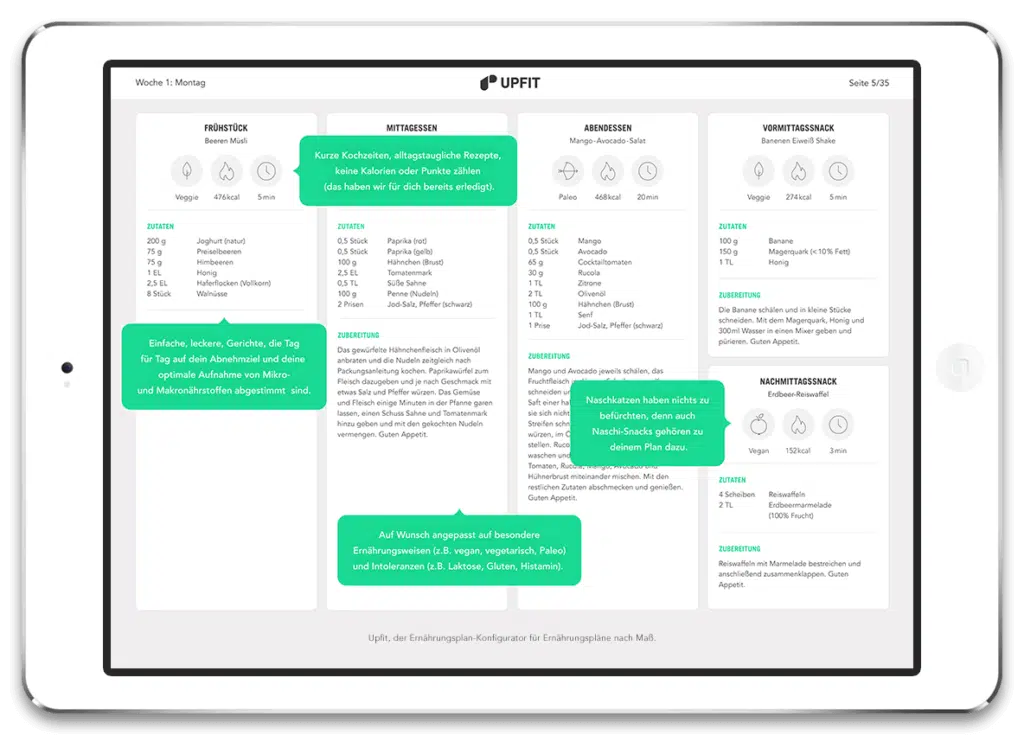BMI calculator from Upfit
Calculate your BMI quickly and easily with the Upfit BMI calculator. If you wish, you can also receive recipes for your personal calorie and nutritional needs via email.
100% free
Science-based
Incl. Calculation of Macro- & Micronutrients
What is the BMI?
BMI = Body Mass Index
The body mass index (BMI) is a guide, which shows you the ratio of your body weight to height. The BMI assumes standardized proportions of the human body and thus provides an orientation as to which weight category the body is in. In the evaluation, a distinction is made between the following categories: underweight, normal weight, overweight, and obesity. The lower the BMI, the lower the weight to height ratio and vice versa.
The BMI gives only an initial superficial assessment, because it does not consider the ratio of muscle mass to body fat, among other important factors. As a result, especially muscular people get a high BMI, even though they are not overweight.
This is how the BMI calculator works
The calculator calculates your BMI by dividing your weight in kilograms by the square of your height. The classification of the weight into a category is based on the corresponding table of the World Health Organization. The table shows a BMI of 18.5 to 24.99 in the normal range. All values below are classified as underweight. Values from 30 and 40 are classified as overweight and obese. Overall, your BMI gives you a clue to assess your weight and health. The Upfit BMI Calculator also provides you with nutritional recommendations to help you normalize your weight as needed.
Example calculation:
A woman weighs 60 kg and is 1.68 m tall.
BMI = body weight [in kg] / (height [in m]) ² = 60 kg / (1.68 m) ² ≈ 21.26
This woman has a BMI of 21.26 and is therefore a healthy normal weight.
BMI Chart
After the BMI Calculator has determined your BMI, you can read where you stand with your weight in our BMI table.
| Category | BMI (kg/m²) |
|---|---|
| Severely underweight | < 16,0 |
| Moderately underweight | 16,0 – 17,0 |
| Slightly underweight | 17,0 – 18,5 |
| Normal weight | 18,5 – 24,9 |
| Overweight | 25,0 – 29,9 |
| Obese Class I | 30,0 – 34,9 |
| Obese Class II | 35,0 – 39,9 |
| Obese Class III | ≥ 40 |
After the BMI Calculator determines your correct values, you can also calculate your basal metabolic rate and your physical activity level. The basal metabolic rate is the energy that your body consumes in complete rest. Your physical activity level represents the extra energy you need for physical activity.
BMI Calculator for Women

The BMI calculator makes no difference between man and woman when calculating the BMI. Only the classification of the weight follows different rules. So the normal range for women is set a little higher. Accordingly, a BMI between 19 and 24 is considered normal in women. This is due to the genetic differences between man and woman.
BMI & Women
The female body genetically has a different ratio of muscle mass to fat than the male. A BMI of 19 and 24 for young women is considered ideal, while men of the same age have an ideal BMI of 20 to 25. With increasing age, the range increases, with the differences between the sexes remaining constant. If you find yourself underweight or overweight, a diet Plan for weight loss or weight gain can help normalize your weight.
BMI Chart for Women
The following chart shows the ideal BMI for women depending on age.
| Age | Ideal BMI Range |
|---|---|
| 16 – 17 | 19 – 24 |
| 18 | 19 – 24 |
| 19 – 24 | 19 – 24 |
| 25 – 34 | 20 – 25 |
| 35 – 44 | 21 – 26 |
| 45 – 54 | 22 – 27 |
| 55 – 64 | 23 – 28 |
| 65 – 90 | 25 – 30 |
After the BMI Calculator determines your correct values, you can also calculate your basal metabolic rate and your physical activity level. The basal metabolic rate is the energy that your body needs at complete rest. Your physical activity level represents the extra energy you need for physical activity.
BMI Calculator for Children

The BMI for children is calculated using the same formula as for adults. The BMI of children and adolescents, however, does not have strict guidelines for subdivision into underweight, normal weight, and overweight.
BMI & Children
The body mass index was developed to assess the weight of an adult in relation to his or her height. It is also possible to calculate the BMI of children and adolescents, but the fat content of the body of children constantly changes. This makes weight assessment difficult with BMI and should therefore be understood as a rough guide only. For better assessment, special BMI standard value curves were set up, also called percentile curves. These are made up of random samples from more than 34,000 German children and are intended to make the BMI more meaningful for children. Nevertheless, the BMI of children should be treated with caution, as the child’s body is sometimes exposed to extreme natural fluctuations and the growth process can vary considerably from child to child.
What is Upfit’s BMI Calculator based on?
We rely on a strong scientific basis and specific empirical values to find out how many calories you should eat and from which nutritional components. To calculate your caloric needs, we use the best and most accurate formula – the so-called Harris-Benedict formula. First we determine your basal metabolic rate (1). Then we determine your physical activity level, known as the PAL factor), we then factor in your personal nutritional goal: either an energy surplus (muscle building), energy balance (maintaining weight) or an energy deficit (losing weight, definition). We divide the resulting amount of calories into the 3 macronutrient groups on according to the latest scientific findings (2, 3, 4) and based on the experience of expert practicing coaches and dietitians. The recommendations on micronutrient intake are based on the guidelines of the World Health Organization (5) and the German Nutrition Society (6). The body weight rating in relation to height is expressed in terms of the BMI value based on the research of Adolphe Quetelet and Ignaz Kaup (7). So we can guarantee a secure, working and efficient tool that optimally supports you on your way to realizing your dream body.
Sources
- Amirkalali, B. et al. (2008). Measuring or predicting resting energy expenditure. Indian Journal of Medical Science Vol. 62 No. 7. S. 283-290.
- Arciero, P. et al. (2016). Protein-Pacing Caloric-Restriction enhances body composition similarly in obese men and women during weight loss and sustains efficacy during long term weight maintenance. Nutrients. 2016 Aug 8 (8), S. 476 ff.
- Petersen, J. (2017). Attenuating the side effects of caloric restriction through exercise and increased protein intake. Nutrition & health sciences dissertations & theses (71). University of Nebraska – Lincoln.
- Helms, E. et al. (2014). A systematic review of dietary protein during caloric restriction in resistance trained lean athletes: a case for higher intakes. International journal of sport nutrition and exercise metabolism (24), S. 127-138.
- Weltgesundheitsorganisation (WHO). Link: http://www.euro.who.int/de/home
- Deutschen Gesellschaft für Ernährung (DGE). Link: https://www.dge.de/
- Quételet, A. (1871): L’anthropométrie ou le mesure des differentes facultés de l’homme. Bruxelles: Muquardt, C.









